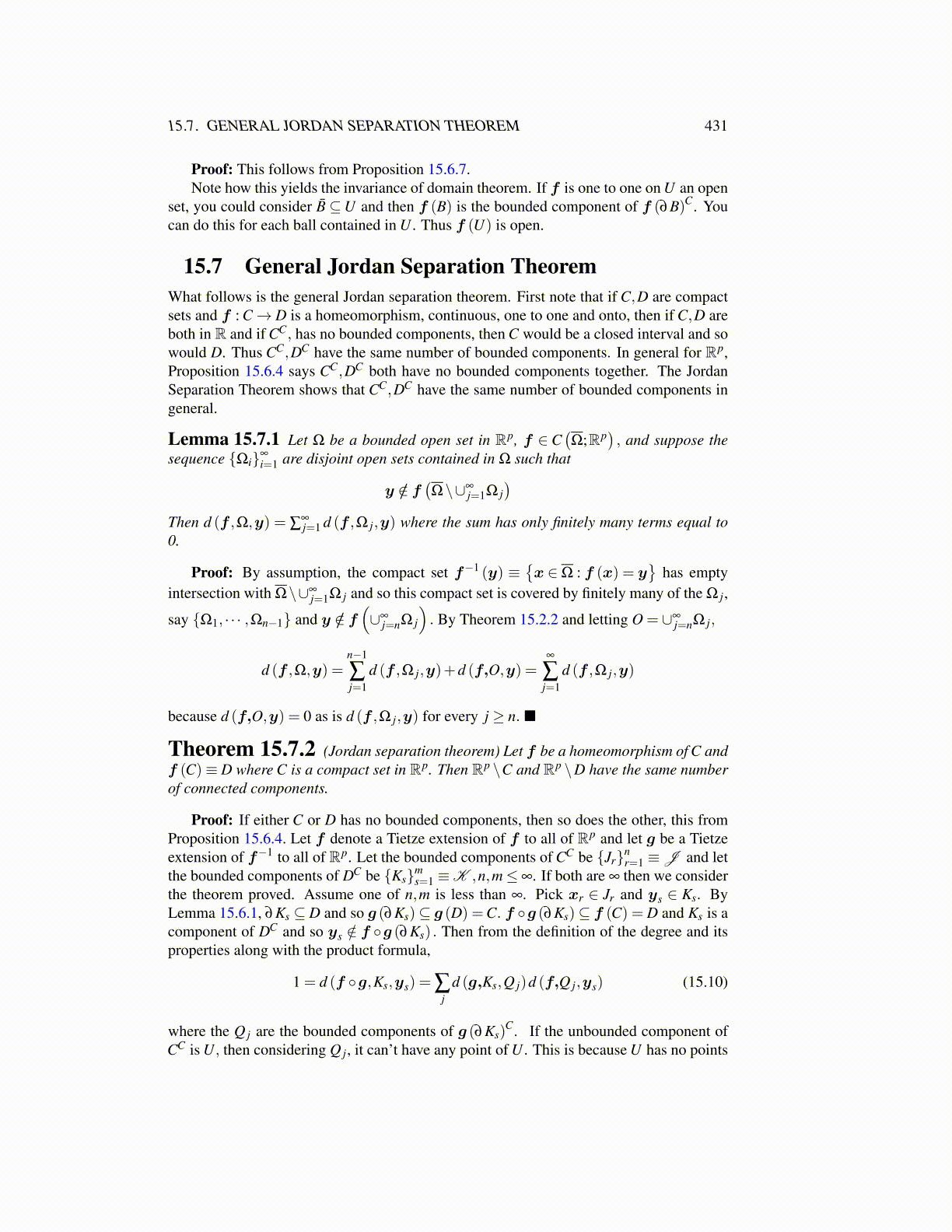
15.7. GENERAL JORDAN SEPARATION THEOREM 431
Proof: This follows from Proposition 15.6.7.Note how this yields the invariance of domain theorem. If f is one to one on U an open
set, you could consider B̄ ⊆U and then f (B) is the bounded component of f (∂B)C. Youcan do this for each ball contained in U . Thus f (U) is open.
15.7 General Jordan Separation TheoremWhat follows is the general Jordan separation theorem. First note that if C,D are compactsets and f : C→ D is a homeomorphism, continuous, one to one and onto, then if C,D areboth in R and if CC, has no bounded components, then C would be a closed interval and sowould D. Thus CC,DC have the same number of bounded components. In general for Rp,Proposition 15.6.4 says CC,DC both have no bounded components together. The JordanSeparation Theorem shows that CC,DC have the same number of bounded components ingeneral.
Lemma 15.7.1 Let Ω be a bounded open set in Rp, f ∈ C(Ω;Rp
), and suppose the
sequence {Ωi}∞
i=1 are disjoint open sets contained in Ω such that
y /∈ f(Ω\∪∞
j=1Ω j)
Then d (f ,Ω,y) = ∑∞j=1 d (f ,Ω j,y) where the sum has only finitely many terms equal to
0.
Proof: By assumption, the compact set f−1 (y) ≡{x ∈Ω : f (x) = y
}has empty
intersection with Ω\∪∞j=1Ω j and so this compact set is covered by finitely many of the Ω j,
say {Ω1, · · · ,Ωn−1} and y /∈ f(∪∞
j=nΩ j
). By Theorem 15.2.2 and letting O = ∪∞
j=nΩ j,
d (f ,Ω,y) =n−1
∑j=1
d (f ,Ω j,y)+d (f,O,y) =∞
∑j=1
d (f ,Ω j,y)
because d (f,O,y) = 0 as is d (f ,Ω j,y) for every j ≥ n. ■
Theorem 15.7.2 (Jordan separation theorem) Let f be a homeomorphism of C andf (C)≡ D where C is a compact set in Rp. Then Rp \C and Rp \D have the same numberof connected components.
Proof: If either C or D has no bounded components, then so does the other, this fromProposition 15.6.4. Let f denote a Tietze extension of f to all of Rp and let g be a Tietzeextension of f−1 to all of Rp. Let the bounded components of CC be {Jr}n
r=1 ≡J and letthe bounded components of DC be {Ks}m
s=1 ≡K ,n,m≤∞. If both are ∞ then we considerthe theorem proved. Assume one of n,m is less than ∞. Pick xr ∈ Jr and ys ∈ Ks. ByLemma 15.6.1, ∂Ks ⊆ D and so g (∂Ks)⊆ g (D) =C. f ◦g (∂Ks)⊆ f (C) = D and Ks is acomponent of DC and so ys /∈ f ◦g (∂Ks) . Then from the definition of the degree and itsproperties along with the product formula,
1 = d (f ◦g,Ks,ys) = ∑j
d (g,Ks,Q j)d (f,Q j,ys) (15.10)
where the Q j are the bounded components of g (∂Ks)C. If the unbounded component of
CC is U, then considering Q j, it can’t have any point of U . This is because U has no points